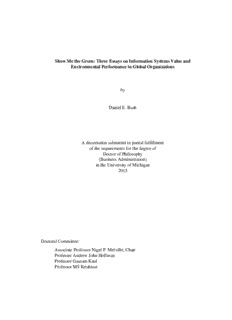
Show Me the Green: Three Essays on Information Systems Value and Environmental Performance ... PDF
Preview Show Me the Green: Three Essays on Information Systems Value and Environmental Performance ...
Show Me the Green: Three Essays on Information Systems Value and Environmental Performance in Global Organizations by Daniel E. Rush A dissertation submitted in partial fulfillment of the requirements for the degree of Doctor of Philosophy (Business Administration) in the University of Michigan 2015 Doctoral Committee: Associate Professor Nigel P. Melville, Chair Professor Andrew John Hoffman Professor Gautam Kaul Professor MS Krishnan Lake Pend Oreille, ID Photo by Mark G. Murray, my childhood hero © Daniel E. Rush 2015 DEDICATION To my family: past, present, and future. ii ACKNOWLEDGMENTS Too many people have provided material support to this effort for me to thank them all by name. Despite the clear danger that I will omit someone who made an absolutely vital contribution, I will nonetheless attempt a partial list. First, I must thank my advisor, Nigel Melville for his patience, thoughtful reflection and keen insights throughout the process of writing this dissertation. I also thank my committee, Andrew Hoffman, Gautam Kaul and MS Krishnan, for their attention, insights and support. I would not have reached the dissertation stage without the engagement of many other Ross faculty, including Michael Gordon, Scott Moore, Hila Etzion, Gerald Davis, Amitabh Sinha, and Gautam Ahuja. I am indebted to the faculty of the then-BIT department who freely offered their comments and support in the early stages of my career: Thomas Schriber, Dennis Severence, Joe Walls, Jerry Peterson, Neil Nelson (and operations stalwart Eric Svaan). I am also appreciative for insights, opportunities and guidance from faculty outside Ross, including Kai Zheng, Charles Friedman, Julia Adler-Milstein, Ronald Ramirez and Kevin Kobelsky. The network of Michigan Ross BIT alumni has been an invaluable support and delight to get to know, for which I must thank Ajit Sharma, Suresh Malladi, Sanghee Lim, Terence Saldanha, Min- Seok Pang, Mark Madrilejo, Andrea Walrath, Sajeev Cherian, Ali Tafti, Ramnath Subramanyam, Narayan Ramasubbu, and Sunil Mithas. Brian Jones, Kelsey Belzak and Roberta Perry of the Ross PhD office are simply indispensable and I am fortunate to have had my administrative life in their charge. iii Similarly, my development as a teacher and writer was profoundly impacted by Karen Bird, Christine Feak and Brenda Imber. I also thank audiences at the following conferences and workshops at which prior versions of this work were presented and refined: 2012 International Conference on Information Systems, 2013 ICOS Dissertation Symposium, 2014 Big 10 IS Symposium, 2014 Americas Conference on Information Systems, 2014 INFORMS annual meeting, and the 2014 Workshop on Information Technology and Systems. The financial support of the Ross School of Business, its TO and BIT departments, ISEF, the Stark Family, the U of M Office of Financial Aid, and the Horace Rackham Graduate School are gratefully acknowledged. Without this support I would not have been in graduate school pursuing my dream. Few journeys are possible without fellow sojourners, and I wish to thank Genna Cohen and many other ICOS participants for involving me in their projects, camps and discussions and teaching me the benefits of collegiality. Similarly, members of the 2012- 2014 PhD forums are gratefully acknowledged for helping me to practice service in the face of adversity. My R4431 office-mates are also thanked for their high-fives, support in difficulty and celebration, not to mention senses of humor. Moving beyond campus, I must thank many friends in Northwood, the men of Friday morning, and numerous coffee-shop, backgammon, and brewing conversation partners who refreshed and revived me throughout this journey. Lastly, this research would not have been possible without the support of my family. To my grandparents, cousins, parents and daughters – thank you for your encouragement, inspiration and love. To my wife – this journey would not have been possible without you. I love you. iv To the almighty, my heavenly father, I thank you for the gift of creation, your presence in it, and the responsibility to care for it. v TABLE OF CONTENTS DEDICATION .................................................................................................................... ii ACKNOWLEDGMENTS ................................................................................................. iii LIST OF TABLES .............................................................................................................. x LIST OF FIGURES .......................................................................................................... xii ABSTRACT ..................................................................................................................... xiii Chapter 1. Introduction and Motivation.............................................................................. 1 Definitions and Positioning............................................................................................. 2 Research Questions ......................................................................................................... 4 Contents and Contributions............................................................................................. 5 References ....................................................................................................................... 8 Chapter 2. IT and Market Value in a Global Context: A Monte Carlo Investigation Informing International Event Studies .............................................................................. 10 Introduction ................................................................................................................... 10 A Brief Literature Review of the Event Study and its Use in IS .................................. 15 Overview of Event Study Estimation Methodology ..................................................... 18 Single Factor (Market) Model .................................................................................. 18 Challenges in Multi-Country Event Studies ............................................................. 20 vi Multiple-Factor (World Market) Model ................................................................... 20 Additional Analyses .................................................................................................. 22 Description of Experimental Setup ............................................................................... 23 Data Generating Process and Simulation Plan.......................................................... 23 Results and Discussion ................................................................................................. 25 Conclusion .................................................................................................................... 28 References ..................................................................................................................... 30 Chapter 3. Market Value of Carbon Management Systems: An International Investigation ...................................................................................................................... 33 Introduction ................................................................................................................... 33 Literature Review.......................................................................................................... 39 CMS Characteristics ................................................................................................. 39 Related CMS Studies ................................................................................................ 40 Theory Foundations and Hypothesis Development .................................................. 42 Research Methodology ................................................................................................. 49 Conventional Event Study Approach........................................................................ 49 International Event Study Considerations ................................................................ 51 Regression Analysis Model ...................................................................................... 53 Data ............................................................................................................................... 56 Collection .................................................................................................................. 56 vii Preparation ................................................................................................................ 59 Synchronize International Markets ........................................................................... 59 Analysis and Results ..................................................................................................... 60 Portfolio and Split Analyses ..................................................................................... 60 Regression Analysis ...................................................................................................... 64 Discussion ..................................................................................................................... 65 Conclusion .................................................................................................................... 67 Limitations ................................................................................................................ 67 Future Research ........................................................................................................ 68 Appendix A: Data Preparation Details ......................................................................... 70 Confounding Events.................................................................................................. 70 Synchronize International Markets ........................................................................... 71 References ..................................................................................................................... 73 Chapter 4. Impact of Enterprise Information Systems on GHG Pollution Emissions Reduction .......................................................................................................................... 79 Introduction ................................................................................................................... 79 Theoretical Background ................................................................................................ 81 IS Impacts on Firm Performance .............................................................................. 82 IS Impacts on Greenhouse Gas Emissions ................................................................ 84 Other Literature Examining Organization‘s CO2 Emissions Output ....................... 86 viii
Description: